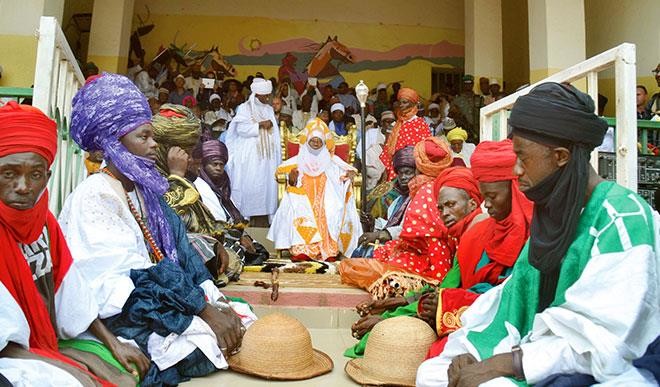
Showmanship, colour, frills and the art of horsemanship are some of the attributes of Sallah Durbars in Northern Nigeria and this year; it was the same in Katsina and Sokoto during the Eid el-fitr celebrations.
Durbars in Katsina Emirate are widely believed to have started during the reign of the first Fulani Emir of Katsina, Ummarun Dallaje, who reigned from 1807 to 1835.
According to information from the emirate council, the Durbar is usually led by the Emir with the aim of expressing joy on Sallah Day and to entertain people on their cultural and historical heritage.
It is also an occasion used in paying homage and reaffirming loyalty by the district heads to the Emir. The durbar also serves to unite the people, bring them closer to the authorities and give them the opportunity to listen to policy statements first hand.
Perhaps this tradition has remained an interesting one as people travel long distances just to catch a glimpse of culture at its best.
For the emirates, two days are set aside for the festivities. On Sallah Day, there is the Hawan Sallah, followed by Hawan Bariki the next day. Both are unique in their own perspectives.
During the Hawan Sallah, which is usually on Eid day, the Emir takes off from his palace, in Kofar-Soro through Bakin-Kasuwa to Kofar-Guga before terminating at the Eid prayer ground for the congregational prayer.
A procession of fully dressed horses, in splendid colourful attire, is usually on display, as drummers, trumpeters, skilled archers, King’s guards known as Yan’ Kwalkwali and Yan’ Sulke, re-enact war-like situations.
To some historians, the procession is similar to what was obtained in war settings in the past and is a way of showing the strength of a kingdom or an emirate.
After the prayers, the Emir returns home in the same procession but through a different route to inspect a guard of honour and receive the traditional homage or ‘Jafi’ from council appointees, traditional title holders and districts head, reaffirming their loyalty and commitment to the emirate.
The following day is the Hawan Bariki. The Emir takes off from the palace to government house to felicitate with the governor and passes on the peoples’ messages, requests and needs to the governor.
The long procession of horse riders is specially formulated according to rank and responsibility. First in the line is the Sarkin Tuta or custodian of the Emir’s flag, followed by Yan-Baka, the archers, then Yan-Busa or the Emir’s trumpeters.
Behind them are the Sarkin Takamar Sarki, followed by Dawakin Zage, which are the Emir’s special extra horses, the princes and Emir’s grandsons and finally the Emir, who is surrounded by his local warriors, the Yan-Baka and Yan-Kwalkwali.
Unlike in the Hawan Sallah where the emir changes his return route, he maintains the same route to and fro his palace in Hawan Sallah, and he receives homage from districts heads and other appointees before the ceremony is rounded up.
However in Sokoto, only a mini Durbar procession is observed to mark the Eid celebration. The horse-riding, popularly known as Hawan Durbar, has been traced back to the colonial era when it was introduced to entertain visiting colonial masters.
Another account said it started right from the time of the Caliphate and has been sustained since then. It is a one-day event which is observed with an array of camels and horse riders who elaborately dress in colourful attires.
Usually, large crowds follow the procession to the palace of the Sultan to witness the displays and pay Sallah homage. Participants are mostly royalty, Dogarai (palace guards), district heads and other title-holders.
The Durbar procession starts from the Eid ground popularly known as Fakon Idi which is some kilometres away from the palace and ends at the palace gate immediately after the Sultan delivers his Sallah message.
Daily Trust gathered that Sultan Ibrahim Dasuki and Sultan Muhammad Maccido never participated in the procession, so also the current Sultan. The last Sultan said to have participated in the procession was Sultan Abubakar III, the father of the present Sultan.
In Zaria, this year’s Hawan Sallah Durbar staged by the Emir of Zazzau, Alhaji Shehu Idris, and some of his counsellors, brought excitement to the residents and visitors to the ancient city.
The joyful mood was not unconnected with the fact that Durbars were cancelled by Zazzau Emirate Council owing to the security challenges experienced in the northern part of the country in the past years.
However, with improvement of security situation, horse riders in full royal regalia brought out the ‘colour and flavour’ of the Sallah for three days.
The Durbar that took place on Wednesday started immediate after the Eid prayers. Tradition demands that immediately after the prayers, the emir and his counsellors would ride on horse backs from the Eid ground to the palace. At the palace, the district heads displayed their skills in horse racing. Every district head paid homage to the emir amidst the cheering of spectators.
On Thursday, the emir and his counsellors were supposed to ride on horsebacks to GRA, Zaria Government House where they ought to have paid homage to the state governor. This tradition was said to have originated from the colonial era where an emir was expected to every year pay homage to the colonial governor and submit his annual report.
Zaria has maintained that tradition and it was named Hawan Bariki. But this did not take place this year and the emirate did not explain what led to the cancellation.
The last durbar in the series known as Hawan Daushe took place yesterday.
According to the city’s tradition, Hawan Daushe was an avenue for an Emir of Zazzau to go round the city and meet his people. District heads and counsellors took turns to pay homage and allegiance to the emir in a competition-like race known as Jehi.
In his Sallah message, Alhaji Idris urged his subjects to always remain peaceful and continue to support the present administration.
While urging leaders to be fair and just to their subjects, the emir said no meaningful development would take place if citizens form the habit of being impatient with their leaders.
Although the insecurity challenges being faced in the North has affected the pomp and pageantry associated with this important cultural display, Hawan Durbar, whenever they are staged, is a spectacle that brings together an array of colours, showmanship and might of traditional institutions of the past.

 Join Daily Trust WhatsApp Community For Quick Access To News and Happenings Around You.
Join Daily Trust WhatsApp Community For Quick Access To News and Happenings Around You.


